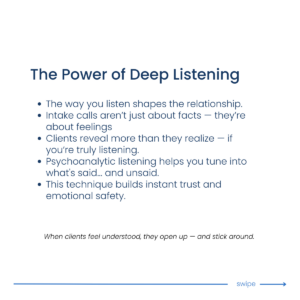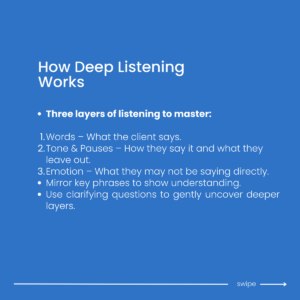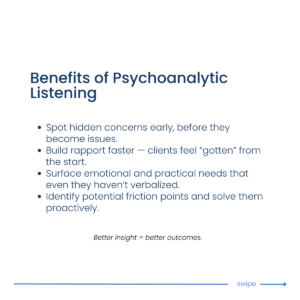The client intake call is a crucial first contact with potential clients. Early in my practice, I focused on gathering basic facts, but a key experience changed my approach. I spoke with a client whose words suggested a simple legal issue, yet their hesitant tone revealed deeper emotional concerns. This sparked my interest in understanding not just the words, but the emotions beneath them, leading me to explore psychoanalytic listening.
Although I am not a psychoanalyst, the insights from this field have reshaped my client intake process. Psychoanalytic listening goes beyond data collection—it uncovers the client’s emotional landscape, fears, and needs. This isn’t about therapy or diagnoses, but about connecting with clients on a human level, building trust, and fostering open communication. Behind every legal issue is a person with complex emotions, and true client-centered representation begins by truly hearing their story.
 The Transformative Power of Deep Listening in Legal Client Intake
The Transformative Power of Deep Listening in Legal Client Intake
The traditional intake process often focuses on efficiency—gathering facts and filling out forms. While important, this can overlook the human element of client interaction. Deep listening helps attorneys uncover clients’ hidden emotions, leading to a deeper understanding of their needs and stronger attorney-client relationships.
Deep listening goes beyond hearing words; it involves paying full attention, sensing emotions, and responding with empathy. This builds trust, uncovers challenges early, and helps attorneys understand the client’s experience, leading to more effective representation.
Uncovering Hidden Needs and Concerns
In the early stages of legal representation, clients may present a seemingly straightforward problem, but underlying concerns often remain unspoken. For example, a client with a breach of contract case might focus on the legal issues, but their true worries could involve reputational damage, stress, or personal relationship strain. These hidden concerns may not be immediately recognized or expressed by the client.
By practicing deep listening, attorneys can uncover these unspoken anxieties and address the full scope of the issue, rather than just the legal problem. Acknowledging these deeper concerns strengthens trust, provides relief, and enables attorneys to develop more comprehensive case strategies and improve client communication.
Building Rapport and Trust
Rapport is the foundation of a successful attorney-client relationship, starting with the intake call or meeting. Deep listening helps build trust by making clients feel heard and understood, encouraging them to share sensitive details. Trust is built not just on legal expertise, but on the attorney’s genuine concern for the client’s well-being.
Attentive and empathetic listening creates an immediate connection. When a client expresses frustration, an attorney who listens and responds with empathy—such as saying, “I can see how challenging this must be”—shows respect for the client’s perspective, fostering security and mutual respect.
Establishing rapport early sets the tone for the relationship. Clients who feel comfortable are more likely to share openly, providing valuable information that helps the attorney assess the case and develop a strategy aligned with the client’s objectives.
Identifying Potential Challenges Early
Deep listening helps identify potential challenges early, such as unrealistic expectations, past negative experiences, or fears about the case outcome. For example, a client dissatisfied with a previous lawyer’s communication may have concerns about your approach. Addressing these concerns early can prevent them from growing and negatively impacting the case or relationship.
By actively listening, an attorney can pick up on these concerns before they escalate. A simple observation, like noticing a client repeatedly mentioning a lack of trust in the legal system, could indicate an issue with their expectations or a deeper fear of failure. Addressing these issues early can prevent misunderstandings later and help the attorney manage the client’s expectations in a healthy, productive way.
Another potential challenge that might surface is difficulty in communication. Clients may not always know how to articulate their concerns or may feel overwhelmed by the complexity of their case. Through deep listening techniques, attorneys can identify when a client is confused, frustrated, or hesitant, allowing them to pause and clarify things before proceeding further.
Gathering More Comprehensive Information Beyond the Facts
In any legal case, facts are essential, but clients’ emotional and psychological states also influence the outcome. Deep listening helps attorneys understand both the legal issues and the emotional impact on the client.
Clients may have concerns about personal, family, or business impacts, or stress about their reputation. These factors might not be clear in a standard intake conversation, but through attentive listening and empathy, attorneys can uncover these insights, allowing them to create a more personalized and effective legal strategy.
Additionally, understanding the client’s emotional and psychological state helps tailor communication in ways that resonate with them. For example, if a client is particularly anxious, offering reassurance and maintaining a calm demeanor can help alleviate their stress. If a client is more analytical, they may appreciate a detailed explanation of the legal process and the steps being taken to resolve the issue.
Enhancing Client Satisfaction with a Client-Centered Approach
A client-centered approach, built on deep listening, significantly boosts client satisfaction. When clients feel understood, they are more satisfied, loyal, and likely to provide positive referrals, boosting the attorney’s reputation and business opportunities.
The intake process is not just about gathering facts; it’s about creating a positive experience where clients feel heard, respected, and valued. Effective listening helps establish trust, laying the groundwork for long-term success and stronger client relationships.
Psychoanalytic Listening Techniques for Elevated Intake Calls
The client intake call is crucial in setting the tone for the attorney-client relationship. While gathering essential facts is important, the process should also focus on building rapport and understanding the client’s emotional and psychological needs. Applying psychoanalytic listening techniques can transform the intake call from a transactional interaction into a more human-centered experience.
These techniques help attorneys and intake staff go beyond the client’s words to understand underlying emotions, anxieties, and concerns. By incorporating active listening, empathy, and nonverbal observation, attorneys can uncover hidden needs, build trust, and create a safe, supportive atmosphere where clients feel heard and understood.
Active Listening: Presence and Focus
The cornerstone of psychoanalytic listening is active listening. Active listening is more than just hearing words; it involves being fully present, attentive, and engaged in the conversation. During intake calls, an attorney’s undivided attention is essential for creating an environment where the client feels heard. It requires minimizing distractions—turning off mobile phones, closing irrelevant tabs on the computer, and focusing solely on the client’s communication.
Maintaining eye contact (in-person or through video calls) is an essential element of active listening. This simple yet powerful gesture signals to the client that they are valued and that their words are important. On the phone, where nonverbal cues are absent, active listening can be enhanced by carefully tuning into the tone and rhythm of the client’s voice. Attorneys should avoid interrupting the client or rushing to fill the silence with their own thoughts. Allowing the client to express themselves fully without interruptions is essential for fostering an open dialogue.
When the attorney practices active listening, it signals to the client that they are not just another case number. The client feels respected and understood, which builds the foundation for trust. An important aspect of active listening is refraining from prematurely offering solutions or opinions. The initial goal is to understand the client’s perspective fully before suggesting any course of action. This patience encourages the client to open up more freely, knowing that they have the space to articulate their concerns.
Empathy: Connecting on a Human Level
Empathy in legal practice means acknowledging and validating a client’s emotions, not necessarily agreeing with everything they say. Clients often bring stress, anxiety, or frustration, especially when dealing with legal matters affecting their personal lives. An attorney who demonstrates empathy helps clients feel their emotions are recognized and their situation taken seriously.
Empathetic listening is shown through both verbal and nonverbal cues. Statements like “I can understand how that would feel frustrating” or “It sounds like you’re really concerned” show the attorney understands the client’s emotional state without rushing to solve the issue. A calm, soothing tone also helps ease the client’s anxiety during the intake call.
When clients feel their emotions are validated, they are more likely to trust the attorney and share additional personal details. Many clients may struggle to express deeper anxieties, but empathy encourages them to open up about aspects of the case that aren’t immediately clear. This deeper understanding helps attorneys craft a legal strategy that addresses both the factual issues and emotional dynamics involved.
Reflecting and Clarifying: Ensuring Mutual Understanding
Reflecting and clarifying are essential techniques in psychoanalytic listening to ensure mutual understanding. Reflecting involves paraphrasing or summarizing the client’s words to confirm accurate understanding. For example, if a client expresses concern about the financial impact of a lawsuit, the attorney might say, “So, you’re worried the costs could significantly affect your finances?” This confirms the attorney’s understanding and reinforces the client’s feelings.
Clarifying involves asking open-ended questions to encourage clients to elaborate on their thoughts and emotions. Questions like, “Can you tell me more about what happened after you received that letter?” help the attorney gain deeper insight into the client’s concerns. These techniques demonstrate that the attorney is not just gathering facts but genuinely seeking to understand the client’s perspective.
By reflecting and clarifying, attorneys can address potential misunderstandings early on and ensure that the client feels fully understood. This creates an atmosphere of mutual respect and reinforces the collaborative nature of the attorney-client relationship.
Observing Nonverbal Cues: Decoding the Unspoken Language
In addition to verbal communication, nonverbal cues—such as body language, facial expressions, and tone of voice—carry significant information that can provide insights into a client’s emotional state. While these cues are more apparent in face-to-face interactions, they can also be observed in virtual or phone conversations.
For example, if a client is speaking softly, hesitating, or avoiding eye contact, it might indicate feelings of uncertainty, fear, or embarrassment. Conversely, if a client is speaking quickly or in an agitated manner, they might be expressing frustration or anxiety. Attorneys who are sensitive to these cues can adjust their approach to better support the client’s emotional needs. For instance, if a client is nervous, the attorney might offer reassurance or ask more gentle, open-ended questions to create a more comfortable atmosphere.
In phone or video calls, tone of voice and speech patterns reveal underlying emotions. Attorneys attuned to these cues can gauge a client’s emotional state and respond with comfort, validation, or further inquiry, leading to a more empathetic and effective response.
Allowing for Silence: Creating Space for Reflection
Silence can be a powerful tool in communication, especially during intake calls. Though it may feel uncomfortable in fast-paced legal environments, moments of silence provide space for both the client and attorney to reflect and process information.
Allowing pauses during a client’s speaking gives them time to think about what to say next. Allowing clients space to reflect before responding fosters a more thoughtful conversation, reduces pressure, and helps them express themselves when ready.
For attorneys, silence provides a moment to process what the client has shared and consider the best response. It prevents the attorney from rushing to conclusions or offering advice prematurely, allowing for a more measured and thoughtful reply.
Avoiding Premature Judgment or Interpretation
Avoiding premature judgment or interpretation is a key aspect of psychoanalytic listening. In legal practice, it’s tempting to jump to conclusions or offer solutions as soon as the facts are presented. However, this can cut off the client’s opportunity to share their full experience and emotional state.
Instead, attorneys should focus on understanding the client’s complete experience by asking open-ended questions and engaging in reflective listening. Rushing to conclusions can give the impression that the attorney isn’t truly listening, which can damage trust and rapport. Taking the time to fully understand the client’s concerns is essential for building a strong relationship.
Managing Emotional Responses: Maintaining Objectivity
Attorneys often face emotionally charged situations during intake calls, where clients may be distressed. It’s crucial for attorneys to manage their own emotions, such as frustration or anxiety, to maintain objectivity and stay grounded in their responses.
Self-awareness and emotional regulation are key to maintaining a composed and empathetic demeanor. Attorneys should practice active listening, empathy, and reflection while maintaining objectivity to avoid personal emotions clouding judgment. This creates a safe, supportive environment where the client’s needs and emotions are prioritized.
Implementing Psychoanalytic Listening in Your Intake Process
Incorporating psychoanalytic listening techniques into the intake process requires careful planning and ongoing support for intake staff. A few strategies for implementing these techniques include:
- Specialized Training: Providing regular training for intake staff on active listening, empathy, and other psychoanalytic techniques is essential. Training can involve role-playing, case studies, and workshops that help staff practice and refine their skills.
- Refined Intake Forms: Intake forms should capture not just factual information, but also the emotional and psychological context of the client’s case. Open-ended questions can help uncover the deeper concerns of the client.
- Supportive Team Environment: Fostering a supportive environment for intake staff is essential to prevent burnout and promote emotional well-being. Regular debriefing sessions and opportunities for self-reflection can help staff improve their listening skills and maintain emotional balance.
- Ongoing Feedback and Supervision: Regular feedback and supervision refine intake staff’s skills and ensure they effectively incorporate psychoanalytic listening techniques into the intake process.
By embracing these strategies, attorneys can create a more empathetic intake process that uncovers hidden concerns, builds trust, and lays the foundation for a successful attorney-client relationship.
Final words: The Strategic Advantage of Deep Listening
Deep listening, grounded in psychoanalytic principles, transforms the client intake process into a meaningful, client-focused experience. By using these listening techniques, attorneys and intake teams uncover concerns, build rapport, and gather key information to shape effective legal strategies. This proactive approach ensures a deeper understanding of client needs and challenges.
In an industry where communication is key, deep listening provides a strategic edge. It enables firms to offer personalized, empathetic service that builds trust and client satisfaction, ultimately leading to better case outcomes. By ensuring clients feel heard and valued from the first contact, deep listening sets the foundation for strong, collaborative attorney-client relationships.


 The Transformative Power of Deep Listening in Legal Client Intake
The Transformative Power of Deep Listening in Legal Client Intake








